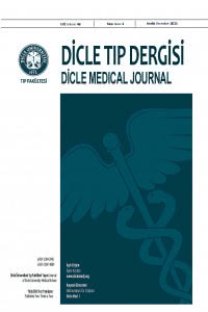The effects of internet use intensity on quality of life, anxiety and depression scores in pediatric migraine
İnternet kullanım sıklığının migrenli çocuk hastalarda yaşam kalitesi, anksiyete ve depresyon skorları üzerine etkileri
___
- 1. Chou C. Internet heavy use and addiction among Taiwanese college students: an online interview study. Cyberpsychol Behav 2001;4:573585.
- 2. Hakala PT, Rimpela AH, Saarni LA, Salminen JJ. Frequent computer-related activities increase the risk of neck-shoulder and low back pain in adolescents. Eur J Public Health 2006;16:536 541.
- 3. Kim K, Ryu E, Chon MY, et al. Internet addiction in Korean adolescents and its relation to depression and suicidal ideation: a questionnaire survey. Int J Nurs Stud 2006;43:185 192.
- 4. Ko CH, Yen JY, Chen CS, et al. Predictive values of psychiatric symptoms for internet addiction in adolescents: A 2-year prospective study. Arch Pediatr Adolesc Med 2009;163:937943.
- 5. Olesen J. International Headache Society classification and diagnostic criteria in children: a proposal for revision. Dev Med Child Neurol 1997;39:138.
- 6. Headache Classification Subcommittee of the International Headache Society. The International Classification of Headache Disorders: 2 nd edition. Cephalalgia 2004; 24 suppl 1 :9.
- 7. Belanger RE, Akre C, Berchtold A, Michauld PA. A Ushaped association between intensity of Internet use and adolescent health. Pediatrics 2011;127:e330-5. doi: 10.1542/ peds.2010-1235.
- 8. Tsitsika A, Critselis E, Kormas G, et al. Internet use and misuse: A multivariate regression analyses of the predictive factors of internet use among Greek adolescents. Eur J Pediatr 2009;168:655-665.
- 9. Louacheni C, Plancke L, Israel M. Teenagers screen-watching habits in their leisure time: use and misuse of internet, play stations and television. Psychotropes 2007;13:3-4.
- 10. Kovacs M. Rating scales to assess depression in schoolage children. Acta Paedopsychatr 1980;46:305-315.
- 11. Spielberger CD. Vagg PR. Psychometric properties of the STAI: a reply to Ramanaiah, Franzen, and Schill. J Pers Assess 1984;48: 87-95.
- 12. Varni JW, Seid M, Rode CA. The PedsQL: measurement model for the pediatric quality of life inventory. Med Care 1999;37:126-139.
- 13. Varni JW, Seid M, Kurtin PS. The PedsQLTM 4.0: reliability and validity of the Pediatric Quality of Life Inventory TM version 4.0 generic core scales in healthy and patient populations. Med Care 2001;39:800-812.
- 14. Varni JW, Burwinkle TM, Seid M. The PedsQL as a pediatric patient-reported outcome: reliability and validity of the PedsQL Measurement Model in 25,000 children. Expert Rev Pharmacoecon Outcomes Res 2005;5:705-719.
- 15. Cakin Memik N, Agaoglu B, Coskun A, et. al. The Validity and Reliability of the Turkish Pediatric Quality of Life Inventory for Children 8-12 Years Old. Turkish Journal of Child and Adolescent Mental Health 2008; 15:87-98.
- 16. Memik NÇ, Ağaoğlu B, Coşkun A, et al. The Validity and Reliability of the Turkish Pediatric Quality of Life Inventory for Children 13-18 Years Old. J Turkish Psych 2007;18:353-363.
- 17. Öy B. Childrens Depression Inventory: a study of reliability and validity. Turk J Psych 1991;2:132136 (In Turkish).
- 18. Özusta S. Turkish standardization, reliability and validity of State Trait Anxiety Inventory for children. Turk J Psych 1995;10:3244 (In Turkish).
- 19. Bados A, Gomez-Benito J, Balaguer G.The state-trait anxiety inventory, trait version: does it really measure anxiety? J Pers Assess 2010;92:560-567.
- 20. Shapira NA, Lessing MC, Goldsmith TD, et.al. Problematic internet use: proposed classification and diagnostic criteria. Depress Anxiety 2003;17:207-216.
- 21. Young KS. Internet addiction: the emergence of a new clinical disorder. Cyberpsychol Behav 1998;1:237-244.
- 22. Ko CH, Yen JY, Chen CC, et al. Proposed diagnostic criteria of internet addiction for adolescents. J Nerv Ment Dis 2005;193:728-733.
- 23. Kautiainen S, Koivusilta L, Lintonen T, et al. Use of information and communication technology and prevalence of overweight and obesity among adolescent. Int J Obes 2005;29:925-933.
- 24. Kim JH, Lau CH, Cheuk KK, et al. Brief report:predictors of heavy internet use and associations with health-promoting and health risk behaviors among Hong Kong university students. J Adolesc 2010;33:215-220.
- 25. Berkey CS, Rockett HR, Colditz GA. Weight gain in older adolescent females: the internet, sleep, coffee, and alcohol. J Pediatr 2008;153:635-639.
- 26. Shapira NA, Goldsmith TD, Keck PE Jr, et al. Psychiatric features of individulas with problematic internet use. J Affect Disord 2000:57:267-272.
- 27. Kaczynski KJ, Claar RL, Lebel AA. Relations Between Pain Characteristics, Child and Parent Variables, and School Functioning in Adolescents With Chronic Headache: A Comparison of Tension-Type Headache and Migraine. J Pediatr Psychol 2012;32:123-127.
- 28. Bernardi S, Pallanti S. Internet addiction: A descriptive clinical study focusing on comorbidities and dissociative symptoms. Compr Psychiatry 2009;50:510-516.
- 29. Milani L, Osualdella D, Di BP. Quality of interpersonal relationships and problematic internet use in adolescence. Cyberpsychol Behav 2009;12:681-684.
- 30. Yen JY, Ko CH, Yen CF, et al. The comorbid psychiatric symptoms of internet addiction: attention deficit and hyperactivity disorder, depression, social phobia, and hostility. J Adolesc Health 2007;41:93-98.
- ISSN: 1300-2945
- Yayın Aralığı: 4
- Başlangıç: 1963
- Yayıncı: Cahfer GÜLOĞLU
Veysel KARS, Necmi ARSLAN, Leyla ERİK, Nuran AVCI, Gamze Pakize BUCAKTEPE, Tahsin ÇELEPKOLU, Hüseyin Avni ŞAHİN
ÖZHAN ÖZGÜR, Şeyda GÜNDÜZ, Metin ERKILIÇ, Hakan Şat BOZCUK
The evaluation of forensic cases reported due to food poisoning
Beyza URAZEL, Adnan ÇELİKEL, Kenan KARBEYAZ, Harun AKKAYA
Sezai ÇELİK, Bülent AYDEMİR, Oya UNCU, TAMER OKAY, Muharrem ÇELİK
Major alt ekstremite cerrahisinde anestezi türünün postoperatif komplikasyonlara etkisi
Murat BAKIŞ, SİNEM SARI ÖZTÜRK, Ayhan Öznur CİLLİMOĞLU, Özgür ÖZBEY, Bakiye UĞUR, MUSTAFA OĞURLU
Echocardiographic evaluation of patients with subacute sclerosing panencephalitis
Derya ÇİMEN, Canan YILDIRIM, BEDRİ ALDUDAK
Kemik metastazlarının iskelet sistemindeki bölgesel dağılımı
Füsun AYDOĞAN, Ebuzer KALENDER, Murat RIFAİOĞLU, Recep DOKUYUCU
Milking yöntemi sonrası persistan ektopik gebelik: Olgu sunumu
Semra KAYATAŞ, Didar KURT, MUSTAFA EROĞLU, Sevcan Arzu ARINKAN, Murat APİ
Mean trombosit volume as a diagnostic indicator in hydatid disease
Şamil GÜNAY, İrfan ESER, Zafer Hasan Ali SAK, İbrahim Can KÜRKÇÜOĞLU
Çocuklarda suprakondiler humerus kırıklarında cerrahi tedavi sonuçlarımız
Beşir DİKMEN, İbrahim Gökhan DUMAN, Raif ÖZDEN, Vedat URUÇ, Yunus DOĞRAMACI, AYDINER KALACI, Serhat KARAPINAR
